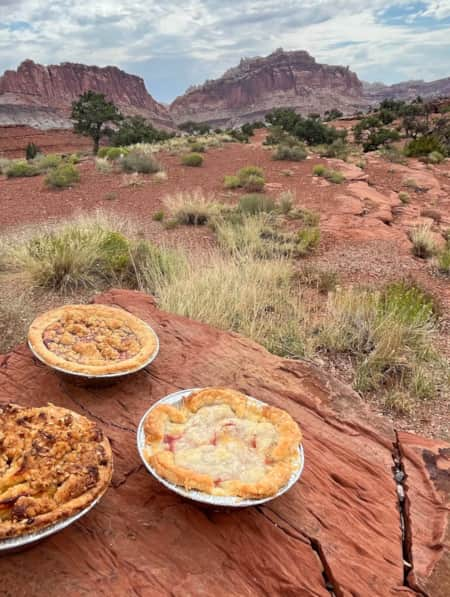- Home
- Places To Go
- Parks & Outdoors
- Monument Valley Navajo Tribal Park

Monument Valley Navajo Tribal Park
- Weather: Mostly Clear, 37F
Monument Valley, an iconic symbol of the American West and the sacred heart of the Navajo Nation, is the ideal setting for your next adventure in the warm, high desert climate of southeastern Utah. Visitors may explore the 17-mile scenic drive in private vehicles or book a jeep tour to explore the area's backroads and sacred lands with the help of a local guide.
The valley is host to towering sandstone rock formations that have been sculpted over time and soar 400 to 1,000 feet above the valley floor. Combined with the surrounding mesas, buttes and desert environment, it truly is one of the natural wonders of the world. Stay the night and step out after dark to appreciate the timelessness and wonder of the Milky Way. Stopping to appreciate the rhythms of this ancient, sacred land has the ability to change your perspective if you take the time to let it.
Monument Valley Fees, Permits & Hours
Monument Valley Navajo Tribal Park is located on the Navajo Nation Reservation, along the state line of southeast Utah and northeast Arizona. The park is a three hour drive from Moab, a little under one hour from Bluff and about 5 hours from Phoenix. Check ahead for current conditions and entrance fees.
- Fees: $8 per person per day. Children 7 and under are free.
- Visitor Center hours: Monday through Friday, 8 a.m. to 5 p.m., year-round.
- Scenic Drive summer hours: 6 a.m. to 8 p.m. Last vehicles are permitted onto the drive at 6 p.m. and must depart it by 8 p.m.
- Closed during all major holidays in accordance with the Navajo Nation: Thanksgiving Day, Christmas Day and New Year’s Day.
- Permits are required for backcountry hiking, camping, filming and various special uses such as weddings. Visit the park’s website for more information on current fees and permits.
- GPS coordinates of park visitor center: 37.002449, -110.172615
Monument Valley Weather
Visitors come to Monument Valley year-round, but most come during spring and autumn to best enjoy the high-desert environment. The onset of searing summer heat usually begins in late May, and it can persist into mid-September. Autumn provides some of the most stable weather of the year. Temperatures may reach mid-90s F in July and August. Clear, warm, sunny days and cool nights make this one of the most delightful seasons to visit.
Winter in Monument Valley can be cold and windy, although there will be some nice days. Average highs in the winter are in the 40s, so you'll want to pack layers and water when you venture out to enjoy serene, sometimes snow-dusted, panoramas.

Goulding's Lodge is tucked under soaring rimrock cliffs two miles west of the Monument Valley.
Photo: Austen Diamond
Where to Stay
The nearest town to Monument Valley is Mexican Hat, a short drive to the northeast on U.S. 163. For more lodging and dining options, continue along this same highway for another 20 minutes to reach Bluff. Accommodations are also available in Kayenta, Arizona, south on U.S. 163. Goosenecks State Park (near Mexican Hat) also has a campground.
Gouldings Lodge is another nearby option and the most convenient place to eat inside the park. This lodge is tucked under soaring rimrock cliffs two miles west of the Monument Valley turnoff from U.S. 163 in Utah. Gouldings also has a nice campground that offers RV hookups, a pool and separate cabins. Explore their guided tour opportunities as well.
The View Hotel is the only lodging inside Monument Valley Navajo Tribal Park. Reservations well in advance are a good idea if you want to enjoy the amazing views of Monument Valley from this modern hotel.
Things to do in Monument Valley
-
Guided Jeep Tours
Butte after butte and mesas upon mesas are calling your name. Guided jeep tours of Monument Valley Navajo Tribal Park are a great way to take in the iconic landscape. It is just as much fun for kids as adults, and a great morning or afternoon activity for families.
-
Hiking the Wildcat Trail
The Wildcat Trail is a 3.2-mile loop hike (4 miles total, including the return to the trailhead and parking area) into one of the most scenic areas that Monument Valley has to offer. This trail lets hikers feel like they stepped back in time into the Wild West.
-
Mexican Hat
Mexican Hat, one of Utah’s strangest rock formations, balances a flattened pancake disk atop a 300-foot-high talus cone. It’s a novel route and quick summit for expert desert rock climbers.
-
Monument Valley Area Scenic Drives
A scenic drive around Monument Valley is one of the area’s most popular activities, and for good reason. High-clearance vehicles are recommended to navigate the dirt, gravel and red rock road.
Showing 0 of 0
Visit with Respect
- You are a guest on the reservation and tribal park land, and allowed on site with the permission of the tribe. Act accordingly. Learn more about Native Nations in Utah.
- Avoid taking pictures of people or events unless you have permission. Remember, this is where people live and work. (Watch: Voices of Bears Ears — The Navajo).
- Act respectfully at all times, but particularly at important sites and burial grounds.
- Don’t remove pottery or other artifacts you may find — this is a violation of federal law. (Read: How to Visit Rock Imagery Sites)
Read the Stories
-

10 Routes Chosen by Utah Cyclists
We reached out to cycling experts and enthusiasts — in some cases to people who literally wrote the book on cycling in Utah — to get a feel for some of Utah's best road cycling routes.
-

15 Non-Technical Slot Canyons
Written By Whitney Childers
7 minute read
You don’t have to be Spider-Man to explore some of the best slot canyons Utah has to offer. You just need to be ready for an adventure in tight spaces with huge photographic rewards
-

5 Places You Can Try Glamorous Camping in Utah
Written By Melissa McGibbon
Experience the fun and adventure of camping with a side of luxury.
-

A Wild Bunch of Apples
Written By Austen Diamond
3 minute read
A new cidery, established in the historic orchard lands of Central Utah, draws upon the paradoxical story of its namesake’s outlaw life running around with Butch Cassidy’s Wild Bunch.
-

A Winter’s Desert: Visiting Southern Utah in the Slow Months
Written By Brinley Froelich
7 minute read
Experiencing the peace of canyon country in the winter is an attraction of its own.
-

Across a Snow-Covered Desert
Written By Matcha
5 minute read
Follow this itinerary for a week-long winter road trip across the snow-covered desert of Southeastern Utah.
-

Alpine Fishing Above the Red Rock Landscapes of Southern Utah
Written By Visit Utah
2 minute read
Sitting just outside of Capitol Reef National Park, this 11,000-foot peak offers views of the surrounding red canyons and desert-like region. In contrast, Boulder Mountain is heavily forested and home to more than 80 lakes, ponds, and reservoirs. With an average rainfall multiple inches more than the lower regions, the area makes for some surprisingly good fishing.
-

An Insider’s Guide to Torrey
Written By Melissa Fields
4 minute read
Look no further than Capitol Reef National Park and nearby Torrey for lesser-traveled red-rock hikes, plenty of lodging options, satisfying dining and night sky as our ancestors knew it.
-

Artisan Cheese in Red Rock Country
Written By Darby Doyle
8 minute read
Two decades ago, Randy Ramsley traded his Dockers-and-tie city job for a 50 acre plot of land that he called a “Garden of Weedin” and the dream of establishing a sustainable farmstead. Now travelers from all over the globe know the small market and counter-service restaurant at Mesa Farm as a refreshing “must-do” respite seemingly plunked in the middle of nowhere on Highway 24 east of Capitol Reef National Park.
-

How to Canyoneer Safely
Written By Edmund Vallance
Whether you’re a newbie or a seasoned canyoneer, here are six expert tips for your next canyoneering adventure.
-

Lakeside Near Torrey: Three Ways
Written By Melissa Fields
Take a trip to this trio of Capitol Reef-area reservoirs where you can swim, fish, kayak and cool-off.
-

Meet the Women Fostering the Arts in Central Utah
Written By Brinley Froelich
4 minute read
Women lead the way in Utah’s regional art galleries and exhibitions.
-

Meet the Women Leading Utah's Food and Beverage Renaissance
Written By Darby Doyle
When it comes to food and beverage in Utah, there are key influencers who have been the proponents of change, growth, and the role of women in Utah’s food scene.
-

Mesa Farm Market
Best local shops and healthy eats near Moab and Capitol Reef. Try the goat cheese!
-

Moonscapes, Marscapes and More
Written By Matcha
If you want to know what Mars looks like — then the dramatic terrain of Capitol Reef National Park and the surrounding lands are a good place to start.
-

Off the Eaten Path: Dining Between the Mighty Five
Written By Paula Colman
6 minute read
Whether you’re visiting a single Utah national park or all five, take time to explore and enjoy the local food on the spectacular routes between the parks.
-

Permit of Solitude in Robbers Roost
Written By Visit Utah
6 minute read
Local guide Christopher Hagedorn leads a group through Robbers Roost in Southern Utah, where wind, water and time has left a primitive maze of canyons.
-

See the Fall Leaves Near Utah's National Parks
Written By Visit Utah
Sure, any of Utah’s Mighty 5 national parks are spectacular year round — covered in snow, peppered with spring wildflowers, and baked in sunshine. But find them exponentially special when the changing fall leaves are in juxtaposition to the immaculate red rock cliffs.
-

Serenity Found in Torrey and Capitol Reef’s Cathedral Valley District
Written By Melissa Fields
5 minute read
Taking Southern Utah’s remote, less-traveled path in Capitol Reef's Cathedral Valley District to nurture your body, mind and spirit.
-

The All-American Road: Scenic Byway 12
Written By Visit Utah
4 minute read
This is 122.863 miles (to be exact) of pure driving bliss. Welcome to Utah’s Scenic Byway 12, a designated All-American Road.
-

Torrey Dining
Written By Melissa Fields
2 minute read
Thanks to it’s location eight miles from Capitol Reef National Park, this remote enclave is a great place to stop for some coffee, ice cream or dinner on your way in or out of the park.
-

Utah’s Pie-Ala-Road: A Sweeter Way to Explore the State
Written By Matcha
Follow the Utah Pie Trail through a scenic landscape of water-sculpted canyons and sandstone peaks and past three iconic national parks to savor the flavor at five delectable pie stops.
-

Utah’s Unexpected Pit Stops
Written By Melissa McGibbon
5 minute read
You’re doing it wrong if you think road trip pit stops are boring layovers on your way to more exciting destinations. How many of these hidden gems have you been to? Here are 11 mini-adventures to check off your list next time you’re road-tripping through Utah.
-

Walking Off the Ledge Into Capitol Reef
Written By Paula Colman
6 minute read
Capitol Reef is breathtaking, but as you stare across the ledge you realize that some of the best scenery is only accessible by dropping in, 20, 50, sometimes 100 feet or more.
-

Winter in Southern Utah Like a Local
Written By Andrew Dash Gillman
4 minute read
Southern Utah comes alive in winter with unexpected experiences for those who are well-prepared and solitude for those who want to expand their view.

























